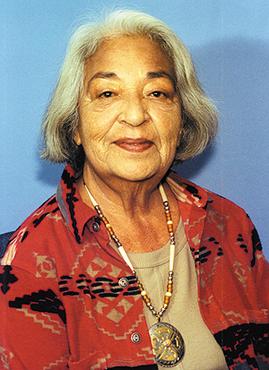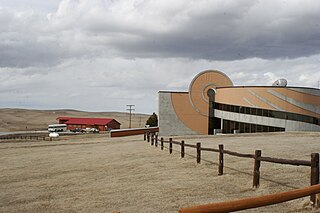Related Research Articles

Native Americans, sometimes called First Americans or Indigenous Americans, are the Indigenous peoples of the United States or portions thereof, such as American Indians from the contiguous United States and Alaska Natives. The United States Census Bureau defines Native American as "all people indigenous to the United States and its territories, including Native Hawaiian and Other Pacific Islanders, whose data are published separately from American Indians and Alaska Natives". The US census tracks data from American Indians and Alaska Native separately from Native Hawaiian and Other Pacific Islanders, who include Samoan Americans and Chamorros.

The Lakota are a Native American people. Also known as the Teton Sioux, they are one of the three prominent subcultures of the Sioux people, with the Eastern Dakota (Santee) and Western Dakota (Wičhíyena). Their current lands are in North and South Dakota. They speak Lakȟótiyapi—the Lakota language, the westernmost of three closely related languages that belong to the Siouan language family.

The Sioux or Oceti Sakowin are groups of Native American tribes and First Nations peoples in North America. The modern Sioux consist of two major divisions based on language divisions: the Dakota and Lakota; collectively they are known as the Očhéthi Šakówiŋ. The term "Sioux" is an exonym created from a French transcription ("Nadouessioux") of the Ojibwe term "Nadowessi", and can refer to any ethnic group within the Great Sioux Nation or to any of the nation's many language dialects.

The Pine Ridge Indian Reservation, also called Pine Ridge Agency, is an Oglala Lakota Indian reservation located almost entirely within the U.S. state of South Dakota, with a small portion in Nebraska. Originally included within the territory of the Great Sioux Reservation, Pine Ridge was created by the Act of March 2, 1889, 25 Stat. 888. in the southwest corner of South Dakota on the Nebraska border. Today it consists of 3,468.85 sq mi (8,984 km2) of land area and is one of the largest reservations in the United States.
Northwest Indian College is a public tribal land-grant community college in Bellingham, Washington. It was established by the Lummi Nation and is the only accredited tribal college or university serving reservation communities of Washington, Oregon, and Idaho.

Haskell Indian Nations University is a public tribal land-grant university in Lawrence, Kansas, United States. Founded in 1884 as a residential boarding school for Native American children, the school has developed into a university operated by the U.S. Bureau of Indian Affairs that offers both associate and baccalaureate degrees. The college was founded to serve members of federally recognized Native American tribes in the United States. It is the oldest continually operating federal school for American Indians.

The Rosebud Indian Reservation is an Indian reservation in South Dakota, United States. It is the home of the federally recognized Rosebud Sioux Tribe, who are Sicangu, a band of Lakota people. The Lakota name Sicangu Oyate translates as the "Burnt Thigh Nation", also known by the French term, the Brulé Sioux.

The Institute of American Indian Arts (IAIA) is a public tribal land-grant college in Santa Fe, New Mexico, United States. The college focuses on Native American art. It operates the Museum of Contemporary Native Arts (MoCNA), which is housed in the historic Santa Fe Federal Building, a landmark Pueblo Revival building listed on the National Register of Historic Places as Federal Building. The museum houses the National Collection of Contemporary Indian Art, with more than 7,000 items.
The American Indian College Fund is a nonprofit organization that helps Native American students, providing them with support through scholarships and funding toward higher education. The fund provides an average of 6,000 annual scholarships for American Indian students and also provides support for other needs at the tribal colleges ranging from capital support to cultural preservation activities. Charity Navigator gave the College Fund an overall rating of 88.36 out of 100.

The Oglala are one of the seven subtribes of the Lakota people who, along with the Dakota, make up the Očhéthi Šakówiŋ. A majority of the Oglala live on the Pine Ridge Indian Reservation in South Dakota, the eighth-largest Native American reservation in the United States.

The Republic of Lakotah or Lakotah is a proposed independent republic in North America for the Lakota people. Proposed in 2007 by activist Russell Means, the suggested territory would be enclaved by the borders of the United States, covering thousands of square miles in North Dakota, South Dakota, Nebraska, Wyoming, and Montana. The proposed borders are those of the 1851 Treaty of Fort Laramie between the United States government and the Lakota. These lands are now occupied by Indian reservations and non-Native settlements. None of the existing Lakota tribal governments support the proposed republic, and they were not consulted about the proposal.

Several Native American tribes within the United States register motor vehicles and issue license plates to those vehicles.

Sinte Gleska University (SGU) is a public tribal land-grant university in Mission, South Dakota, on the Rosebud Indian Reservation. It is a Brulé Lakota Indian Reservation home to the Sicangu. SGU has an enrollment of 828 full and part-time students. It is regionally accredited by the Higher Learning Commission.
Rebecca Adamson is an American businessperson and advocate. She is former director, former president, and founder of First Nations Development Institute and the founder of First Peoples Worldwide.

Patricia A. Locke was a Native American educator, activist, and prominent member of the Baháʼí Faith. She worked closely with indigenous activists in supporting the American Indian Religious Freedom Act. After joining the Baháʼí Faith in 1988, she was elected as the first Native American woman to serve on the National Spiritual Assembly of the Baháʼís of the United States.
St. Joseph's Indian School is an American Indian boarding school, run by the Congregation of the Priests of the Sacred Heart just outside the city of Chamberlain, South Dakota, on the east side of the Missouri River. The school, located in the Roman Catholic Diocese of Sioux Falls and named after Saint Joseph, is operated by a religious institute of pontifical right that is independent of the diocese. The school is within two hours of three reservations of the Lakota people: the Cheyenne River Indian Reservation, the Lower Brule Indian Reservation and the Crow Creek Indian Reservation, whose children comprise the majority of students at the school. The Akta Lakota Museum and Cultural Center is located on the campus and is owned by the school.

Oglala Lakota College (OLC) is a public tribal land-grant community college in Kyle, South Dakota. It enrolls 1,456 students enrolled part- and full-time. OLC serves the Pine Ridge Indian Reservation, which has a population of about 26,000 and covers 3,468 square miles in southwestern South Dakota.
David Archambault II is the former (2013–2017) tribal chairman of the Standing Rock Indian Reservation in North Dakota. He was instrumental in the Dakota Access Pipeline protests and continues to work to promote an understanding of the historical treaty rights and indigenous rights of Native American people. Archambault holds degrees in Business Administration and Management. In 2017 he joined FirstNation HealthCare as its chief consulting officer.
The prison–industrial complex is the rapid expansion of US inmates and prisons in favor of private prison companies and businesses that profit from the services needed in the construction and maintaining of prisons. The businesses benefit and profit from cheap prison labor, food services, medical services, surveillance technology, and construction. The financial incentive of building prisons encourages incarceration and affects people of color at disproportionately high rates. Native Americans are the largest group per capita in the US prison system and are more likely to be affected by police violence than any other racial group.

The impact of the COVID-19 pandemic on Native American tribes and tribal communities has been severe and has emphasized underlying inequalities in Native American communities compared to the majority of the American population. The pandemic exacerbated existing healthcare and other economic and social disparities between Native Americans and other racial and ethnic groups in the United States. Along with black Americans, Latinos, and Pacific Islanders, the death rate in Native Americans due to COVID-19 was twice that of white and Asian Americans, with Native Americans having the highest mortality rate of all racial and ethnic groups nationwide. As of January 5, 2021, the mortality impact in Native American populations from COVID-19 was 1 in 595 or 168.4 deaths in 100,000, compared to 1 in 1,030 for white Americans and 1 in 1,670 for Asian Americans. Prior to the pandemic, Native Americans were already at a higher risk for infectious disease and mortality than any other group in the United States.
References
- ↑ "Human Services : Social Services - First Nations Development Institute". charitynavigator.org. Retrieved 24 February 2017.
- ↑ "About Us First Nations". firstnations.org. Retrieved 24 February 2017.
- ↑ "About Us First Nations". firstnations.org. Retrieved 24 February 2017.
- ↑ Smith College Special Collections. "Guide to the Rebecca Adamson papers". Smith College Finding Aids. Retrieved 3 April 2020.
- ↑ "Lakota Funds Mission". Lakota Funds. Retrieved 24 February 2017.
- ↑ "Oweesta About Us". Oweesta. Retrieved 24 February 2017.
- ↑ "CAMPUS LIFE; Minnesota: Training Indians To Become Business Leaders". The New York Times. February 3, 1991. Retrieved 24 February 2017.
- ↑ First Nations Development Institute Biennial Report, 1994/95. July 1995. Retrieved 24 February 2017.
{{cite book}}:|website=ignored (help) - ↑ "First Peoples Worldwide About Us". First Peoples Worldwide. Retrieved 24 February 2017.
- ↑ Jean Ness (November 15, 2001). "Building Native Communities: Financial Skills for Families". Tribal College Journal. Mancos, CO. Retrieved 24 February 2017.
- ↑ W.K. Kellogg Foundation (July 30, 2014). "Reclaiming Healthy Food Systems in Indian Country". Native News Online. Retrieved 24 February 2017.
- ↑ Adamson, Rebecca (March 24, 2002). "Mascot supporters insult Native peoples". Indian Country Today Media Network. Retrieved 14 May 2018.
- ↑ Mary Reed. "Longmont executive promotes economic development for Native Americans". GetBoulder.com. Brock Media. Retrieved 24 February 2017.
- ↑ "Nonprofit moves to Longmont". Denver Business Journal. Denver, CO: American City Business Journals. March 20, 2006. Retrieved 24 February 2017.
- ↑ "Native American Asset Watch: Rethinking Asset Building in Indian Country". VAWnet. January 2009. Retrieved 24 February 2017.
- ↑ "Food Sovereignty Summit". nativefoodnetwork.com. Native Food Network. April 22, 2013. Retrieved 24 February 2017.
- ↑ "20th Annual L.E.A.D. Institute Conference". nativephilanthropy.org. Native Americans In Philanthropy. September 2015. Retrieved 24 February 2017.
- ↑ Foxworth, Ray (May 27, 2016). "Skins Poll: Tribes Have Spoken, Which Is All That Matters". Indian Country Today Media Network. Retrieved 15 May 2018.
- ↑ Cox, John Woodrow; Clement, Scott; Vargas, Theresa (May 19, 2016). "New poll finds 9 in 10 Native Americans aren't offended by Redskins name". The Washington Post. Retrieved 15 May 2018.
- ↑ "WKKF Awards $2.5 Million to Transform Image of Native Americans". Philanthropy News Digest. August 31, 2016. Retrieved 14 May 2018.
- ↑ "First Nations Development Institute - GuideStar Profile". guidestar.org. GuideStar. Retrieved 24 February 2017.
- ↑ "Videos". BBB Wise Giving Alliance. Retrieved 21 November 2017.
- ↑ "First Nations Development Institute - Charity Navigator Historical Ratings". charitynavigator.org. Charity Navigator. Retrieved 1 December 2021.